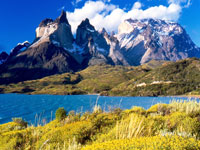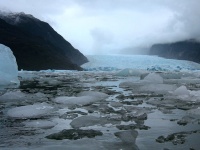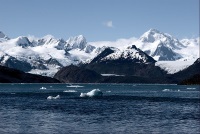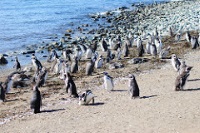Chilean Patagonia Travel Guide
Fjords, glaciers and magnificent scenery attract visitors to the vast wilderness of Chilean Patagonia. The north, or Aisen region, can be likened to the Inside Passage of Alaska or New Zealand's Fjordland on South Island, with its dramatic ice and waterway scenery, while Southern Patagonia (or Magallanes) is rugged, mountainous and stormy.
It was nearly 500 years ago that Portuguese explorer Ferdinand Magellan guided four ships through the treacherous passages that are still thought of as the 'End of the World'. Today, Patagonia is inhabited by nearly two million people, though the majority of them live on the Argentinian side. Even there, the region is still almost entirely dominated by pristine nature.
The gravel highway known as the Carretera Austral is a pathway to one of the world's last great expanses of wilderness. It begins at the port of Chaiten and continues to the capital of northern Patagonia, Coyhaique, both of which are good bases for explorations of Chilean Patagonia. The most popular attraction in this region, despite the difficulty and expense of getting here, is the two million-hectare (four million-acre), glacier-filled Parque Nacional Laguna San Rafael, which has some of the world's most spectacular mountain- and fjord scenery.
Magallanes features glacially sculpted mountains and harsh landscapes, with the jewel in its crown, Torres del Paine National Park, being the most famous of the southern region's protected areas. Even further south is the town of Puerto Natales, terminus of the extraordinary ferry trip through the fjords from Puerto Montt, and the main exploration base for the region. Beyond the continent lies the harsh and stormy archipelago of Tierra del Fuego, stretching towards icy Antarctica.
The best way to visit the region is to fly into Santiago and book a flight with a low-cost airline to reach Patagonia; accommodation options range from design-forward hotels to cypress-wood cabins set in pine woods and remote ecolodges. There are many tour groups that offer multiple day- or week packages, and the best time to venture to the region is from November to early March, which is summertime in the southern hemisphere. Autumn (March, April, and May) and Spring (September, October, and November) are also good times to visit, as they experience mild temperatures and fewer crowds.
Things to do in Chilean Patagonia
Chilean Patagonia boasts some of the most astoundingly beautiful and diverse wilderness areas in the world and vast swathes of this adventurer's paradise remain unspoilt and unpopulated. It is therefore no surprise that the majority of things to see and do in Chilean Patagonia revolve around natural wonders and outdoor activities. The dramatic scenery includes glaciers, lakes, rivers, mountains and volcanoes; enough natural splendour to keep visitors occupied for months.
The Parque Nacional Laguna San Rafael and The Parque Nacional Torres Del Paine are both UNESCO Biosphere Reserves and are open to the public. They offer a number of hiking trails of varying lengths and difficulties, which is a popular way to explore these special areas. San Rafael includes the Northern Patagonian Ice Field and the mammoth glaciers to be found here are some of the most popular attractions in Chilean Patagonia. Torres Del Paine is a magnificent reserve with towering granite mountains and crystal-clear lakes. Pumalin Park, in northern Patagonia, is also a favourite with travellers for its fjords and rainforest.
The Magdalena Island Penguin Reserve is a birdwatcher's dream and worth a visit for anyone keen on spotting these comical birds. The ferry trip to get there will take travellers into the Strait of Magellan, which is special in its own right. For those interested in past explorers, such as Magellan, who first ventured into this area, it is worth visiting the Nao Victoria Museo, which displays a full-size model of the ship Magellan used, among others, and provides intriguing historical lessons about life on board. The museum is in Punta Arenas and has received acclaim in recent years.
Chilean Patagonia is full of attractions, particularly for the intrepid traveller keen to kayak, hike and climb. The amount of wilderness to explore actually leaves visitors spoilt for choice.
Travellers should be aware that, outside of the main travel hubs, amenities are extremely limited in Chilean Patagonia and getting around can prove tricky. Many visitors travel by plane or ship and others rent vehicles owing to the lack of reliable public transport. The further south travellers want to go, the more difficult it becomes, but it is worth it.

Parque Nacional Torres del Paine
A UNESCO Biosphere Reserve, this 180,000-hectare (442-acre) park is the pride and joy of southern Chile. The park takes its name from the towering granite pillars that rise over 6,560 feet (2,000m) above the Patagonian plains. It is a hiker's paradise thanks to many excellent, well-developed trails that traverse astounding changes in scenery.
The hikes consist of several circuits that vary in length and difficulty. There are highly competent and informative guides available, but unaccompanied hikes are also allowed. This amazing freedom is part of the appeal of the wilderness area for adventurers. Turquoise lakes and roaring waterfalls, forests and magnificent rambling glaciers, icy rivers, daisy-filled meadows, harsh mountain passes and plenty of wildlife, including the protected guanaco (wild relative of the llama), are all part of what makes this park so attractive.
Visitors can also try their hand at outdoor activities such as horseback riding, sailing, kayaking, rock climbing and fly-fishing. Two famous areas within the park are the French Valley and Silence Valley (only accessible with a guide). The sunrise hike to the towers that gives the park its name is also highly recommended. The Parque Nacional Torres del Paine features prominently on discerning travellers' bucket lists, and for very good reason.

Parque Nacional Laguna San Rafael
Remote and dramatically beautiful, Parque Nacional Laguna San Rafael lies on Chile's southern Pacific coast and is one of the largest national parks in the country. Created in 1959, its rugged terrain covers an area of 6,726 square miles (17,420 sq km) and includes the Northern Patagonian Ice Field. It was named after the San Rafael Lagoon, which was created by the retreat of the San Rafael Glacier, and has been designated a World Biosphere Reserve by UNESCO. A fjord more than 10 miles (16km) long is one of the park's main attractions, along with some of the highest peaks in Patagonia, several glaciers, lakes and a rich variety of bird and sea life.
While the majority of visitors to Laguna San Rafael never set foot on land, the magnificent views from the boat will no doubt stay with them for a lifetime. If visitors take one of the larger boat trips to see the famous glaciers in the park, they will almost certainly get the opportunity to approach the ice flow in smaller boats and get up close to the glacier.
For the really adventurous there are also multi-day sea kayaking tours of the area. Most visitors describe the trip as a once-in-a-lifetime, unforgettable experience and it isn't hard to see why when one considers the wondrous landscape. The glaciers are melting, making this attraction even more poignant and special; in a few years' time the landscape may well be very different.

Chilean Tierra del Fuego
In the furthest southern reaches of Patagonia, at the tip of South America, lies the archipelago of Tierra del Fuego, which translates to 'Land of Fire'. It is a dramatic name for a dramatic place, as the harsh winds of the subpolar climate sweep over rocky mountains, sparse tundra and hardy forests.
Tierra del Fuego is an increasingly popular eco-travel destination, and adventurous travellers come to see wildlife that includes sea lions, foxes, condors, owls and firecrown hummingbirds. Hiking and camping are popular activities, and the archipelago offers some of the best trout fishing in South America.
While the savage natural beauty of the area is the main attraction for travellers, there is also more traditional touristic sightseeing on offer. Much of the tourism in Tierra del Fuego revolves around 'southernmost' things: the port town of Puerto Williams claims to be the southernmost city in the world; the southernmost cathedral and temple are located in Punta Arenas; and, while Cape Horn is widely thought to be the southernmost island in South America, that title actually goes to The Diego Ramírez Islands, which are nesting grounds for many species of southern seabirds, including albatross, penguins and petrels. Travellers with a sense of adventure looking to get off the beaten track will find Tierra del Fuego to be quite a revelation.

Magdalena Island Penguin Reserve
Magdalena Island is located 21.7 miles (35km) south of Punta Arenas, and the Magdalena Island Penguin Reserve is a paradise for birdwatchers, or for anybody who is fond of penguins. The reserve is a natural bird sanctuary, and is home to more than 100,000 birds, including about 95 percent of the world's population of Magellanic Penguins as well as cormorants and seagulls.
Because it is protected, the only facilities on Magdalena Island are for scientific research and not tourism. However, guided tours are available to see the penguins in their natural habitat, and the lighthouse at the Environmental Interpretation Centre provides stunning panoramic views of the region. There are ferries available from Puntas Arenas, which take approximately two hours each way and provide snacks and coffee. These ferry rides are in themselves thrilling as the boat crosses the famous Straits of Magellan, traversing the same waters as Sir Francis Drake and Charles Darwin did centuries ago.
Generally, visitors are allowed about an hour on the island to observe the penguins in their natural habitat. The birds are naturally curious and always amusing. They return every year between October and March to lay their eggs and raise their young, so lucky visitors may even see chicks.
Chilean Patagonia Climate and Weather
Chilean Patagonia experiences less severe weather conditions than travellers might think, with the east featuring a slightly warmer climate than the west. Temperatures vary greatly depending on where exactly visitors are. In the extreme south of Chilean Patagonia the weather is moderated by its proximity to the ocean and only slight seasonal variety is experienced. The months of April and May are the wettest, with reliable snowfall from June through September. The depletion of the ozone layer over the South Pole is a growing concern and is thought to be the reason for an increase in blindness and skin cancer in sheep in Tierra del Fuego. So, travellers visiting Chilean Patagonia are advised to bring plenty of sunscreen, regardless of the time of year, and to apply it liberally even if it doesn't feel hot. As it is often wet and windy, it is also a good idea to come prepared with waterproof gear no matter what the season.
The overwhelming consensus is that the best time of year to visit Patagonia is in the warmer summer months, between December and February, when average temperatures range comfortably between 50F (10C) and 64°F (18C) in northern Patagonia.
Chile travel info
Electricity
Electrical current is 220 volts, 50Hz. Round two-pin plugs and round three-pin plugs are used.
Language
The official language is Spanish.
Money
The local currency is the Chilean peso (CLP), which is divided into 100 centavos. Visa, MasterCard, Diners Club and to a lesser extent, American Express, are accepted in most large shops and hotels. ATMs are widely available.
Tipping
Tips of about 10 percent are expected in restaurants; it's usual to round up the fare for taxi drivers if they help with the luggage. Tipping small amounts is customary for most services.
Health
All eligible travellers should be up to date with their COVID-19 vaccines; vaccinations for hepatitis A, hepatitis B are recommended, and a typhoid vaccine may be recommended for long-term travellers who plan to visit rural areas and eat outside of hotels and restaurants. Water is generally safe in the cities, but should be treated in the rural areas; bottled water is widely available for drinking. Santiago is severely polluted and this could cause respiratory problems or eye irritations, particularly between May and August. Travellers visiting the Andes Mountains should be aware of altitude sickness, and ascend slowly to allow the body to adjust. Healthcare in urban areas is generally good, but hospitals and clinics are expensive. Comprehensive travel health insurance is recommended.
Safety
Chile is a politically stable country with few safety threats to travellers. Incidences of pick-pocketing and mugging are on the increase in big cities and travellers should take care of their belongings, especially around tourist areas and bus stations. Travellers should also avoid walking alone late at night, and should be particularly cautious in Valparaiso and the capital, Santiago, where theft is on the increase, and muggings are becoming more common in popular walking areas such as Cerro San Cristobal, Cerro Santa Lucia and Cerro Manquehue. There has been an increase in reports regarding people receiving spiked drinks at nightclubs and bars, particularly in Santiago. Travellers should avoid any involvement in political protests and demonstrations, which take place from time to time. Chile has a landmine problem, which is mainly restricted to border areas adjacent to Peru and Bolivia. These areas are seldom visited by most travellers, so landmines shouldn't be a problem. However, visitors are advised to stick to marked roads, obey all signs and seek the advice of local authorities if travelling to these areas.
Local customs
Although Chile is largely conservative in outlook, homosexuality is legal and is increasingly widely accepted socially. Punishment for the possession and consumption of drugs is illegal and can lead to prison sentences.
Doing business
Chilean business culture tends to be formal, and this includes dress, which should also be conservative. In business, Chileans should be addressed by their titles and surnames, unless otherwise stated. Businesses are often family run. Third party introductions are indispensable when arranging a meeting, and developing a personal relationship is key. Chileans often stand very close when conversing and it is impolite to pull away. Visitors are also expected to re-confirm appointments before arriving at a meeting. Foreigners should be on time for meetings, but it is not unusual for the host to be 15 to 30 minutes late. On introduction, a firm handshake and exchange of business cards is usual; cards should be printed in both English and Spanish, and it's important to pay attention to the card before putting it away carefully. Business hours are generally 9am to 5pm Monday to Friday, often with a siesta over lunch.
Duty free
Travellers entering Chile do not need to pay customs duty on 400 cigarettes, 50 cigars (large or small) and 500g tobacco; 2.5 litres of alcohol; and perfume for personal use. Meat products, flowers, fruit and vegetables may only be imported if permission is given by the Department of Agriculture.
Communications
The international access code for Chile is +56. The outgoing code is 00 followed by the relevant country code (e.g. 0044 for the United Kingdom). Hotels, cafes and restaurants offering free WiFi are widely available. As international roaming costs can be high, purchasing a local prepaid SIM card can be a cheaper option.
Passport & Visa
A return or onward ticket is required, and it's recommend that passports be valid for six months after the intended period of travel. Extension of stay is possible for an additional 90 days for visa exempt visitors.
Entry requirements
No visa is required by US nationals for visits of up to 90 days, though a passport valid on arrival is required for travel to Chile. Travellers who visit Easter Island are allowed to stay for a maximum of 30 days.
UK nationals do not require a visa for visits of up to 90 days, though a passport valid on arrival is required. Travellers who visit Easter Island are allowed to stay for a maximum of 30 days.
No visa is required by Canadians for visits of up to 90 days; a passport valid on arrival is required for travel to Chile. Travellers who visit Easter Island are allowed to stay for a maximum of 30 days.
Australian nationals require a visa and passport valid on arrival. Travellers who visit Easter Island are allowed to stay for a maximum of 30 days.
South African nationals must hold a passport valid on arrival, though a visa is not required for stays of up to 90 days. Travellers who visit Easter Island are allowed to stay for a maximum of 30 days.
Irish nationals must hold a passport valid on arrival, but a visa is not required for a stay of up to 90 days. Travellers who visit Easter Island are allowed to stay for a maximum of 30 days.
New Zealand nationals must hold a passport valid on arrival, though a visa is not required for a stay of up to 90 days. Travellers who visit Easter Island are allowed to stay for a maximum of 30 days.
Useful contacts
Chile National Tourism Website: www.chile.travel
133 (Police); 131 (Medical)Embassies / consulates in other countries
Embassy of Chile, Washington DC, United States: +1 202 530 4104.
Embassy of Chile, London, United Kingdom: +44 (0)20 7222 2361.
Embassy of Chile, Ottawa, Canada: +1 613 235 4402.
Embassy of Chile, Canberra, Australia: +61 (0)2 6286 2430.
Embassy of Chile, Pretoria, South Africa: +27 (0)12 460 8090.
Embassy of Chile, Dublin, Ireland: +353 (0)1 667 5094.
Embassy of Chile, Wellington, New Zealand: +64 (0)4 471 6270.
Embassies / consulates in Chile
United States Embassy, Santiago: +56 (0)2 330 3000
British Embassy, Santiago: +56 (0)2 370 4100.
Canadian Embassy, Santiago: +56 (0)2 652 3800.
Australian Embassy, Santiago: +56 (0)2 550 3500.
South African Embassy, Santiago: +56 (0)2 8200 300.
Embassy of Ireland, Buenos Aires (also responsible for Chile): +54 11 5787 0801.
New Zealand Embassy, Santiago: +56 (0)2 616 3000.



